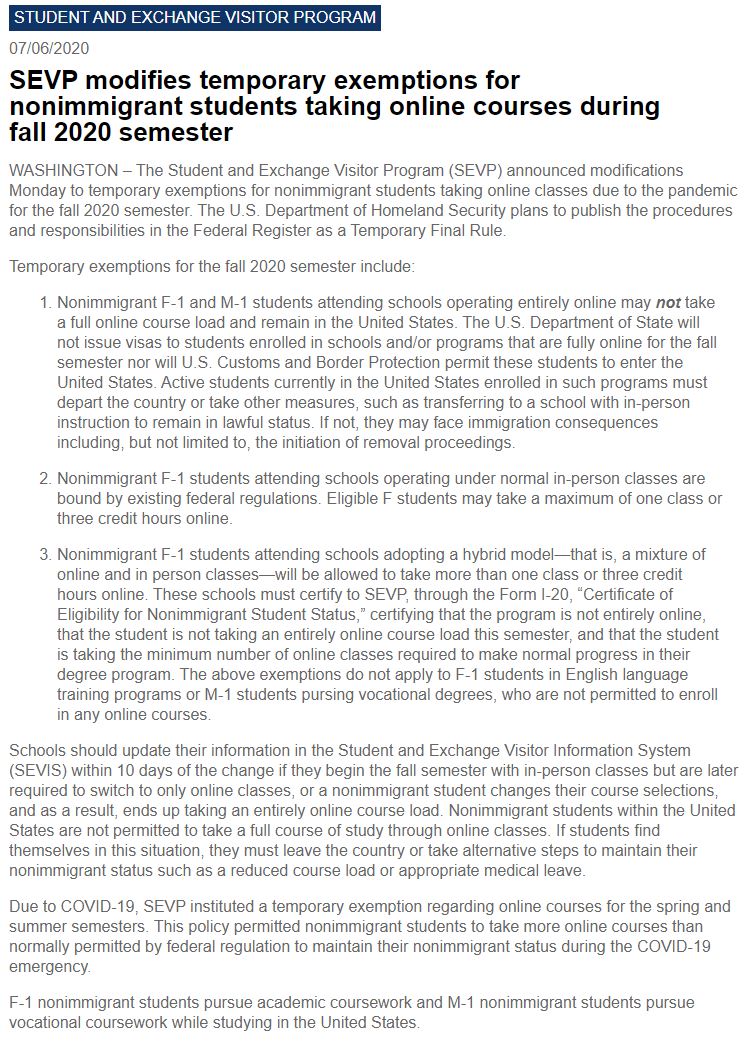NOTE: On July 14, 2020, DHS rescinded its rule in face of multiple lawsuits. See update here.
On Monday, the Student and Exchange Visa Program (SEVP) issued a new rule affecting international students as they prepare for the fall semester. According to the rule, foreign students on F-1 or M-1 visas may not remain in the US if they are taking a full online course load. No visas will be issued to students who have enrolled in universities that are operating solely online. Any students already in the US attending schools that have switched to online teaching must leave the US or take other measures. Many foreign students and their families are now scrambling to learn of their schools’ plans for the fall semester and facing the daunting prospects of relocating or even having their study plans dashed altogether.

In response to Covid-19 pandemic, many universities have chosen not to reopen campuses, switching to online instruction for fall courses. According to the Chronicle for Higher Education, tracking more than 1000 universities, already 9% have decided to switch to online-only courses, while 31% will implement a hybrid model or are still deciding how to proceed. As of this week, 60% are still planning to open campuses. (See updated list here)
Under normal non-pandemic years, foreign students on nonimmigrant visas may take only one course online. Earlier this March, for the spring and summer semesters, SEVP granted exemptions allowing students to take more online courses than normally permitted under regulations. SEVP has abruptly shifted course for the fall. But for students participating in hybrid programs, SEVP may allow students to take more than one online course and enter or remain in the US on a nonimmigrant student visa.
Covid-19 Demonstrates Instability of Nonimmigrant Visas
The impact of the Covid-19 pandemic highlights the inherent instability in nonimmigrant visas. Many international students enter the US to pursue their studies with hope to live and work in the US, ultimately immigrating usually by first obtaining the nonimmigrant H-1B work visa. However, the H-1B program has been repeatedly the target by the US government, especially during the Trump administration, seeking to limit its benefits and even suspending the program altogether. To make matters worse, obtaining after obtaining the H-1B work visa, the road to get the green card through EB-2 or EB-3 can be exceedingly long for some.
EB-5 Immigrant Investor Visa Program – A Faster Option
Investing through the EB-5 Program can be a faster and easier option to obtain a US green card. (Learn more about the EB-5 Program’s basic requirements and process.) After the EB-5 Program was modified under new regulations implemented last November, increasing the required investment amount to $900,000, the number of new EB-5 petitions have dropped drastically. In fact, only 21 new EB-5 I-526 petitions were filed between January and March 2020. Previously backlogged countries, such as India, are now current. And according to recent USCIS historical averages, the processing times for the I-526 approval is estimated for petitions filed this year is 13 months on average. See Behring’s blog on updated USCIS processing times.
Learn More
To learn more about the new rules impacting international students or to learn if you qualify for the EB-5 Program, contact Behring and schedule a free consultation with a member of our team. Behring hosts an expansive library of EB-5 resources available for download as well as FAQs and blogs to provide the best information to prepare you for your EB-5 investment.
